.22 rimfire rifle sound moderators
If you are using a .22LR rifle, sound reduction is only required for subsonic ammunition. It is quite straightforward to…
Win CENS ProFlex DX5 earplugs worth £1,149 – enter here
Jason Harris looks at the four best .22 rimfire bolt-action rifles on the market
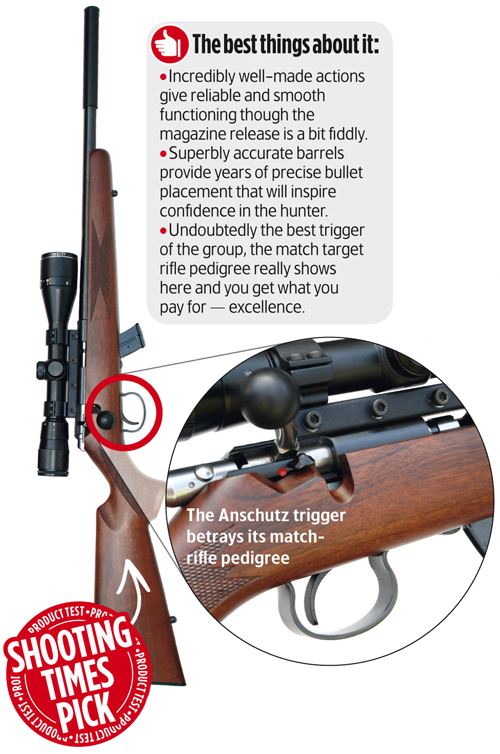
The humble .22 rifle is fairly ubiquitous these days. Most gun cabinets will have at least one rimfire for pest and vermin control, but the choice can be bewildering. This guide should help you make some decisions.
Heavy varmint barrel? Synthetic or wood stock? Perhaps a better trigger or the ability to change barrels and therefore calibres?
In my opinion you can’t go far wrong with a .22 rimfire rifle, whether you buy one new or second-hand.
Rimfires are robust and here I have compared four different .22 rifles which include a variety of attractive features and prices.
1. Anschutz XIV Carbine. This version of the Model 64 has a 14″ barrel and sporter stock of walnut or beech. Longer barrels and thumbhole stocks are available.
2. Ruger M77/22 Carbine. The American-made Ruger is almost a miniaturised version of the company’s popular M77 full-bore rifle.
3. CZ 452 Style. A sporter-style rifle with synthetic stock and either a 20 or 16″ barrel length. This model has a set trigger as standard.
4. Sako Quad. The Quad has a quick barrel change facility and choice of synthetic, wood and varmint models making it incredibly versatile.
This is a short, highly accurate and reliable rimfire with excellent build quality. (Read the full review here). Anschutz has led the way in offering short or carbine-length barrels in its rimfire range.
If you’re looking for resell value in a .22 rifle then an Anschutz would make a good investment as they hold their value. This model has a good trade-in value too if you fancy an upgrade later on.
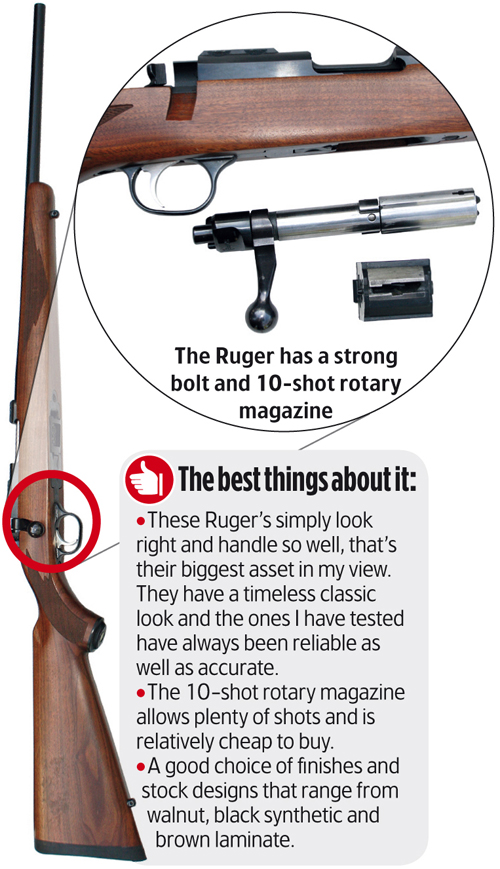
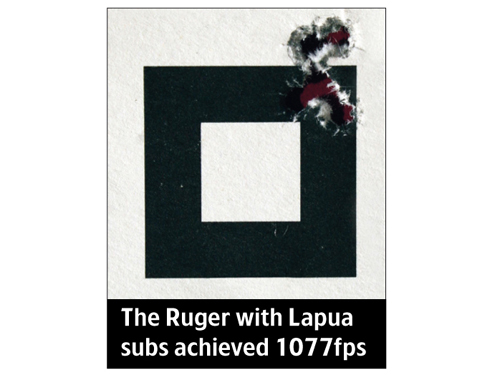
If you spot a Ruger for sale second-hand then you should seriously considering buying it. Owners tend to hang on to them because of the Ruger’s fine construction and simple, plain accuracy.
As with the CZ 452, they seem to mature well and the action becomes smooth with a bit of use.
If there is a downside, it’s that you have to use the rifle’s own scope mounting system, although you can make it more universal with a Ruger to Weaver basemount conversion.
Accuracy is enhanced by quick firing-pin lock times.
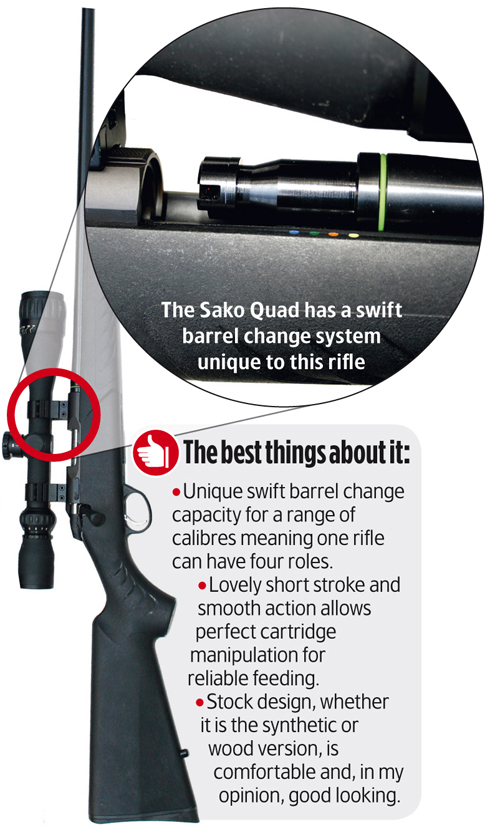
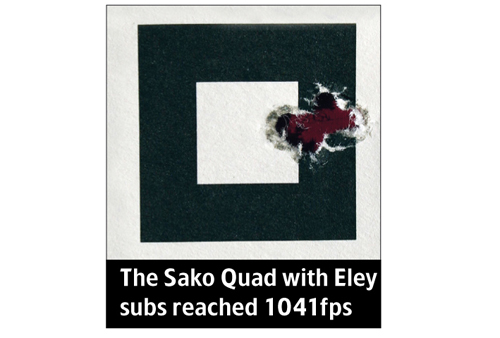
The Quad takes the .22 rifle from Sako to the next level of versatility, thanks to a quick barrel-change facility. Mind you, I miss the old Finnfire design.
Sako’s rifles are consistently accurate and I am a fan of the synthetic stocks’ styling and practicalities. There is also an excellent selection of models, with the good varmint heavy barrelled version which, when fitted with the walnut stock, gives a solid and stable platform to achieve greater longer range accuracy.
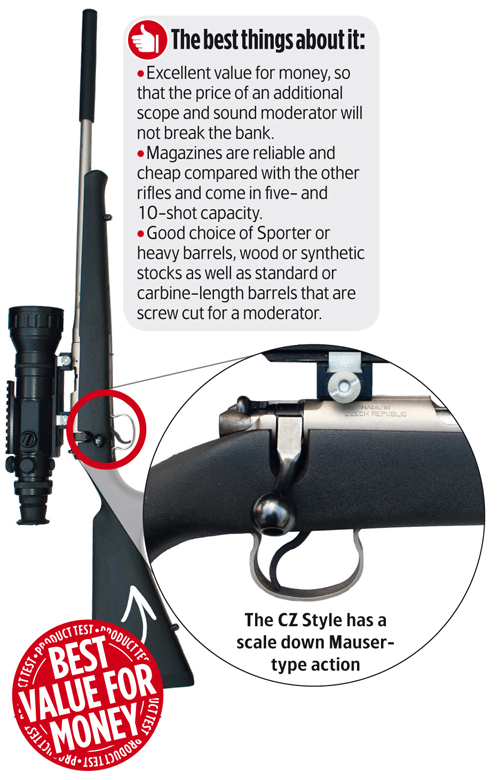
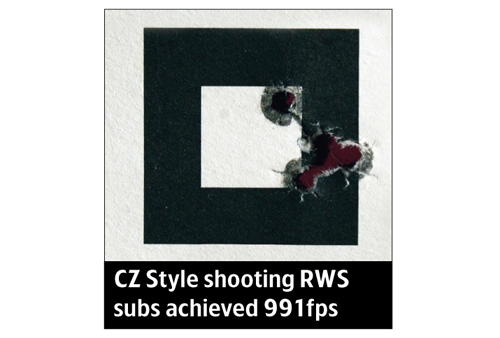
Despite only getting a four star rating, the CZ 452 rifle series is the most fondly considered and prolific rimfire rifle around and has some faithful owners.
There is a greater range of styles available and they are virtually indestructible. Though the 452 model has a slightly heavier trigger, this unit has a new feature to the Brno range with a trigger-guard that, when set forward, gives the trigger a lighter pull weight.
Rimfires usually lock the bolt from locking lugs sited at the back of the bolt, not at the face. In this way they differ from full-bore rifles.
The CZ: Features classic petite Mauser-design action and bolt assembly. The bolt is beautifully miniaturised to fit the .22LR cartridge with a short bolt throw, while the bolt has a twin extractor claw arrangement with a fixed blade ejector. Reliable and simple, what more could you want?
The Sako: The action reminds me of the old Finnfire design, but has been modified for swift barrel release mechanism to accommodate four calibres — .17Mach 2, .17HMR, .22LR and .22WMR. The bolt works fast due to the low bolt lift angle and short bolt throw, and the handle has a moulded plastic shroud with faceted edges making for a comfortable grip. Unlike the CZ, extraction is via a single extractor claw. Because all the four calibres share the same rim dimensions, extraction is good. The trigger guard is a polymer-moulded unit. Metal would have been my preference to be honest.
The Ruger: Another steel action. There are three integral proprietary scope-mounting slots to the top of the action. The bolt is quite large for a rimfire with a length of more than 6in (the CZ is 5in). In two halves, the front half of the bolt has twin guiding rails to stop it binding in operation. There are two opposed extractor claws that ensure positive extraction, while the rear section of the bolt has two large locking lugs that lock down vertically and solidly to the action. The bolt handle is short with a polished semi-round knob and designed for a firm hold. Useful for a vermin rifle because it allows positive, quick, follow-up shots.
The Anschutz XIV: The match-grade Model 64 from its target range. Beautifully made. You will enjoy the smooth operation and reliable feeding, coupled with positive ignition. The bolt is light with twin extractors that provide positive case extraction. The ejector, sited in the bottom of the receiver, energetically clears empties.
Often overlooked to create a fancier stock or better scope, the trigger unit is in fact often the key to a rifle’s accuracy.
All the four .22 rifles I have picked out have good triggers, some are more precise than others. The CZ unit has a slim trigger blade, and though there is an adjustable trigger the CZ would benefit from a lighter pull. But most people will be content with the factory unit.
All four rifles have good safeties.
The CZ, Sako and Anschutz have options of five- or 10-shot detachable magazines. Ruger’s rotary magazine is only available in 10-shot capacity.
Each works well, but there’s a big price difference for spares. Only the Anschutz is all-steel — it’s also the priciest to lose.
Something for all tastes here whether you want to go down the practical synthetic route or plain sporter beech up to varmint-profiled stocks and quality walnut.
CZ has some really nice walnut on its rifles and the chequering is always well cut, though the Style’s synthetic black stock is sturdy and perfect for rough use.
So too is the Sako’s polymer stock with angled finger grooves instead of chequering, though their walnut stocks are pleasantly heavy and balance well.
Ruger rimfire stocks are always elegant, but its black plastic or laminated models are for those that use rimfires daily.
Finally, Anschutz only offer wood stocks in this range, which is a pity, but the stock on the XIV rifle is a classic sporter style. It’s a bit plain, but nice to handle.
As with CZ, Anschutz offers a thumbhole stock version which looks fabulous and gives a good grip, especially when lamping in a 4×4.
The rimfire industry has now realised that most people in Britain cut off at least 8in of barrel to retro-fit a sound moderator.
Anschutz first offered the 14in short model. CZ soon followed with the 16in barrel range.
Sako and Ruger are screw-cut for a sound moderator.
Sako, Anschutz and CZ all offer barrels in sporter and heavy varmint profiles if you desire, and though .17HMR versions of the same rifles are available within each manufacturer’s range, it is only the Sako that has a quick-change facility.
A swift unscrew of a single securing clamp and the Sako can fit any of the .17 Mach 2, .17HMR, .22LR or .22WMR barrels so any vermin can be engaged.
If you are using a .22LR rifle, sound reduction is only required for subsonic ammunition. It is quite straightforward to…
Why the .22 is perfect for rabbit hunters
Just about all the rimfire rifles on the market today are of such a quality that they will easily harvest a rabbit at 50 yards — much depends on the style you like and how deep your pockets are.
In summary, all four rifles are accurate, available in many styles and stock choices and near bombproof in construction. Pests won’t want you going anywhere near them.
Get the latest news delivered direct to your door
Discover the ultimate companion for field sports enthusiasts with Shooting Times & Country Magazine, the UK’s leading weekly publication that has been at the forefront of shooting culture since 1882. Subscribers gain access to expert tips, comprehensive gear reviews, seasonal advice and a vibrant community of like-minded shooters.
Save on shop price when you subscribe with weekly issues featuring in-depth articles on gundog training, exclusive member offers and access to the digital back issue library. A Shooting Times & Country subscription is more than a magazine, don’t just read about the countryside; immerse yourself in its most authoritative and engaging publication.

